Forest Above-Ground Biomass Estimation Using Single-Baseline Polarization Coherence Tomography with P-Band PolInSAR Data
Abstract
:1. Introduction
2. Study Area and Data Sets
2.1. Study Area
2.2. Field Data
2.3. Polarimetric SAR Data
3. Methodology
3.1. Polarization Coherence Tomography
3.2. The Retrieval Method of Canopy Height (Hac)
3.3. Model Construction and Validation
4. Experimental Results and Analysis
4.1. Tomographic Profiles
4.2. Parameter Retrieval
4.3. Forest AGB Estimation
5. Discussion
6. Conclusions
Acknowledgments
Author Contributions
Conflicts of Interest
References
- Bonan, G.B. Forests and climate change: Forcings, Feedbacks, and the Climate Benefits of Forests. Science 2008, 320, 1444–1449. [Google Scholar] [CrossRef] [PubMed]
- Kindermann, G.E.; McCallum, I.; Fritz, S.; Obersteiner, M. A global forest growing stock, biomass and carbon map based on FAO statistics. Silva Fenn. 2008, 42, 387–396. [Google Scholar] [CrossRef]
- Pan, Y.; Birdsey, R.A.; Houghton, R.; Kauppi, P.E.; Kurz, W.A.; Phillips, O.L.; Shvidenko, A.; Lewis, S.L.; Canadell, J.G.; Ciais, P.; et al. A Large and Persistent Carbon Sink in the World’s Forests. Science 2011, 333, 988–993. [Google Scholar] [CrossRef] [PubMed]
- Askne, J.I.H.; Fransson, J.E.S.; Santoro, M.; Soja, M.J.; Ulander, L.M.H. Model-based biomass estimation of a Hemi-Boreal forest from multitemporal TanDEM-X acquisitions. Remote Sens. 2013, 5, 5725–5756. [Google Scholar] [CrossRef]
- Houghton, R.A. Aboveground forest biomass and the global carbon balance. Glob. Chang. Biol. 2005, 11, 945–958. [Google Scholar] [CrossRef]
- Houghton, R.A.; Hall, F.; Goetz, S.J. Importance of biomass in the global carbon cycle. J. Geophys. Res. Biogeosci. 2009, 114. [Google Scholar] [CrossRef]
- Lu, D. The potential and challenge of remote sensing-based biomass estimation. Int. J. Remote Sens. 2006, 27, 1297–1328. [Google Scholar] [CrossRef]
- Powell, S.L.; Cohen, W.B.; Healey, S.P.; Kennedy, R.E.; Moisen, G.G.; Pierce, K.B.; Ohmann, J.L. Quantification of live aboveground forest biomass dynamics with Landsat time-series and field inventory data: A comparison of empirical modeling approaches. Remote Sens. Environ. 2010, 114, 1053–1068. [Google Scholar] [CrossRef]
- Gibbs, H.K.; Brown, S.; Niles, J.O.; Foley, J.A. Monitoring and estimating tropical forest carbon stocks: Making REDD a reality. Environ. Res. Lett. 2007, 2, 045023. [Google Scholar] [CrossRef]
- Uddin, K.; Gilani, H.; Murthy, M.S.R.; Kotru, R.; Qamer, F.M. Forest Condition monitoring using very-high-resolution satellite imagery in a remote mountain watershed in Nepal. Mt. Res. Dev. 2015, 35, 264–277. [Google Scholar] [CrossRef]
- Yu, Y.; Saatchi, S. Sensitivity of L-band SAR backscatter to aboveground biomass of global forests. Remote Sens. 2016, 8, 522. [Google Scholar] [CrossRef]
- Anderson, G.L.; Hanson, J.D.; Haas, R.H. Evaluating Landsat thematic mapper derived vegetation indices for estimating above-ground biomass on semiarid rangelands. Remote Sens. Environ. 1993, 45, 165–175. [Google Scholar] [CrossRef]
- Steininger, M.K. Satellite estimation of Tropical Sencondary forest above-ground biomass: Data from Brazil and Bolivia. Int. J. Remote Sens. 2000, 21, 1139–1157. [Google Scholar] [CrossRef]
- Baccini, A.; Laporte, N.; Goetz, S.J.; Sun, M.; Dong, H. A first map of tropical Africa’s above-ground biomass derived from satellite imagery. Environ. Res. Lett. 2008, 3, 45011–45019. [Google Scholar] [CrossRef]
- Sinha, S.; Jeganathan, C.; Sharma, L.K.; Nathawat, M.S. A review of radar remote sensing for biomass estimation. Int. J. Environ. Sci. Technol. 2015, 12, 1779–1792. [Google Scholar] [CrossRef]
- Su, Y.J.; Guo, Q.H.; Xue, B.L.; Hu, T.Y.; Alvarez, O.; Tao, S.L.; Fang, J.Y. Spatial distribution of forest aboveground biomass in China: Estimation through combination of spaceborne lidar, optical imagery, and forest inventory data. Remote Sens. Environ. 2016, 173, 197–199. [Google Scholar] [CrossRef]
- Funning, G.J.; Parsons, B.; Wright, T.J. Fault slip in the 1997 Manyi, Tibet earthquake from linear elastic modelling of InSAR displacements. Geophys. J. Int. 2007, 169, 988–1008. [Google Scholar] [CrossRef]
- Furuya, M.; Satyabala, S.P. Slow earthquake in Afghanistan detected by InSAR. Geophys. Res. Lett. 2008, 35, 160–162. [Google Scholar] [CrossRef]
- Schulz, W.H.; Kean, J.W.; Wang, G. Landslide movement in southwest Colorado triggered by atmospheric tides. Nat. Geosci. 2009, 2, 863–866. [Google Scholar] [CrossRef]
- Cai, J.; Wang, C.; Mao, X.; Wang, Q. An adaptive offset tracking method with SAR images for landslide displacement monitoring. Remote Sens. 2017, 9, 830–845. [Google Scholar] [CrossRef]
- Dowdeswell, J.A.; Unwin, B.; Nuttall, A.; Wingham, D.J. Velocity structure, flow instability and mass flux on a large Arctic ice cap from satellite radar interferometry. Earth Planet. Sci. Lett. 1999, 167, 131–140. [Google Scholar] [CrossRef]
- Goldstein, R.M.; Engelhardt, H.; Kamb, B.; Frolich, R.M. Satellite radar interferometry for monitoring ice sheet motion: Application to an antarctic ice stream. Science 1993, 262, 1525–1530. [Google Scholar] [CrossRef] [PubMed]
- Lopez-Sanchez, J.M.; Vicente-Guijalba, F.; Erten, E.; Campos-Taberner, M.; Garcia-Haro, F.J. Retrieval of vegetation height in rice fields using polarimetric sar interferometry with tandem-x data. Remote Sens. Environ. 2017, 192, 30–44. [Google Scholar] [CrossRef]
- Le Toan, T.; Beaudoin, A.; Riom, J.; Guyon, D. Relating forest biomass to SAR data. IEEE Trans. Geosci. Remote Sens. 1992, 30, 403–411. [Google Scholar] [CrossRef]
- Le Toan, T.; Quegan, S.; Woodward, I.; Lomas, M.; Delbart, N.; Picard, G. Relating radar remote sensing of biomass to modelling of forest carbon budgets. Clim. Chang. 2004, 67, 379–402. [Google Scholar] [CrossRef]
- Mermoz, S.; Réjou-Méchain, M.; Villard, L.; Le Toan, T.; Rossi, V.; Gourlet-Fleury, S. Decrease of L-band SAR backscatter with biomass of dense forests. Remote Sens. Environ. 2015, 159, 307–317. [Google Scholar] [CrossRef]
- Santos, J.; Lacruz, M.; Araujo, L.; Keil, M. Savanna and tropical rainforest biomass estimation and spatialization using JERS-1 data. Int. J. Remote Sens. 2002, 23, 1217–1229. [Google Scholar] [CrossRef]
- Saatchi, S.; Marlier, M.; Chazdon, R.; Clark, D.; Russell, A. Impact of spatial variability of tropical forest structure on radar estimation of aboveground biomass. Remote Sens. Environ. 2011, 115, 2836–2849. [Google Scholar] [CrossRef]
- Carreiras, J.; Melo, J.B.; Vasconcelos, M.J. Estimating the above-ground biomass in Miombo Savanna woodlands (Mozambique, East Africa) using L-band synthetic aperture radar data. Remote Sens. 2013, 5, 1524–1548. [Google Scholar] [CrossRef]
- Mermoz, S.; Le Toan, T.; Villard, L.; Réjou-Méchain, M.; Seifert-Granzin, J. Biomass assessment in the Cameroon savanna using ALOS PALSAR data. Remote Sens. Environ. 2014, 155, 109–119. [Google Scholar] [CrossRef]
- Sandberg, G.; Ulander, L.M.H.; Fransson, J.E.S.; Holmgren, J.; Le Toan, T. L- and P-band backscatter intensity of biomass retrieval in hemiboreal forest. Remote Sens. Environ. 2011, 115, 2874–2886. [Google Scholar] [CrossRef]
- Ranson, K.J.; Sun, G. Mapping biomass of a northern forest using multi-frequency SAR data. IEEE Trans. Geosci. Remote Sens. 1994, 32, 388–396. [Google Scholar] [CrossRef]
- Saatchi, S.; Halligan, K.; Despain, D.G.; Crabtree, R.L. Estimation of forest fuel load from radar remote sensing. IEEE Trans. Geosci. Remote Sens. 2007, 45, 1726–1740. [Google Scholar] [CrossRef]
- Robinson, C.; Saatchi, S.; Neumann, M.; Gillespie, T. Impacts of spatial variability on aboveground biomass estimation from L-band radar in a temperate forest. Remote Sens. 2013, 5, 1001–1023. [Google Scholar] [CrossRef]
- Ranson, K.J.; Sun, G. Effects of environmental conditions on boreal forest classification and biomass estimates with SAR. IEEE Trans. Geosci. Remote Sens. 2000, 38, 1242–1252. [Google Scholar] [CrossRef]
- Santos, J.R.; Freitas, C.C.; Araujo, L.S.; Dutra, L.V.; Mura, J.C.; Gama, F.F.; Soler, L.S.; SantAnna, S.J.S. Airborne P-band SAR applied to the aboveground biomass studies in the Brazilian tropical rainforest. Remote Sens. Environ. 2003, 87, 482–493. [Google Scholar] [CrossRef]
- Cartus, O.; Santoro, M.; Kellndorfer, J. Mapping forest aboveground biomass in the Northeastern United States with ALOS PALSAR dual-polarization L-band. Remote Sens. Environ. 2012, 124, 466–478. [Google Scholar] [CrossRef]
- Pulliainen, J.T.; Kurvonen, L.; Hallikainen, M.T. Multitemporal behavior of L- and C-band SAR observations of boreal forests. IEEE Trans. Geosci. Remote Sens. 1999, 37, 927–937. [Google Scholar] [CrossRef]
- Fu, H.; Wang, C.; Zhu, J.; Xie, Q.; Zhao, R. Inversion of vegetation height from PolInSAR using complex least squares adjustment method. Sci. China Earth Sci. 2015, 58, 1018–1031. [Google Scholar] [CrossRef]
- Wang, C.; Wang, L.; Fu, H.; Xie, Q.; Zhu, J. The impact of forest density on forest height inversion modeling from Polarimetric InSAR data. Remote Sens. 2016, 8, 291. [Google Scholar] [CrossRef]
- Fu, H.; Wang, C.; Zhu, J.; Xie, Q.; Zhang, B. Estimation of pine forest height and underlying dem using multi-baseline P-band PolInSAR data. Remote Sens. 2017, 9, 363. [Google Scholar] [CrossRef]
- Xie, Q.; Zhu, J.; Wang, C.; Fu, H.; Lopez-Sanchez, J.M.; Ballester-Berman, J.D. A modified Dual-Baseline PolInSAR method for forest height estimation. Remote Sens. 2017, 9, 819. [Google Scholar] [CrossRef]
- Le Toan, T.; Quegan, S.; Davidson, M.; Balzter, H.; Paillou, P.; Papathanassiou, K.; Plummer, S.; Rocca, F.; Saatchi, S.; Shugart, H.; et al. The BIOMASS mission: Mapping global forest biomass to better understand the terrestrial carbon cycle. Remote Sens. Environ. 2011, 115, 2850–2860. [Google Scholar] [CrossRef]
- Neumann, M.; Saatchi, S.S. Assessing performance of L- and P-band polarimetric interferometric SAR data in estimating boreal forest above-ground biomass. IEEE Trans. Geosci. Remote Sens. 2012, 50, 714–726. [Google Scholar] [CrossRef]
- Hansen, E.H.; Gobakken, T.; Solberg, S.; Kangas, A.; Ene, L.; Mauya, E.; Næssse, E. Relative efficiency of ALS and InSAR for biomass estimation in a Tanzanian Rainforest. Remote Sens. 2015, 7, 9865–9885. [Google Scholar] [CrossRef] [Green Version]
- Pardini, M.; Kugler, F.; Lee, S.K.; Sauer, S.; Torano-Caicoya, A.; Papathanassiou, K. Biomass estimation from forest vertical structure: Potentials and Challenges for multi-baselin Pol-InSAR techniques. In Proceedings of the European Conference on PolInSAR, Rome, Italy, 24–28 January 2011; ESA: Paris, France, 2011. [Google Scholar]
- Treuhaft, R.N.; Chapman, B.D.; Dos Santos, J.R.; Goncalves, F.G.; Dutra, L.V.; Graca, P.; Drake, J.B. Vegetation profiles in Tropical forests from multibaseline lnterferometric synthetic aperture radar, field and lidar measurements. J. Geophys. Res. 2009, 114, D23110. [Google Scholar] [CrossRef]
- Treuhaft, R.N.; Goncalves, F.G.; Drake, J.B.; Chapman, B.D.; Dos Santos, J.R.; Dutra, L.V.; Graca, P.M.L.A.; Purcell, G.H. Biomass estimation in a Tropical Wet forest using Fourier transforms of profiles from lidar or interferometric SAR. Geophys. Res. Lett. 2010, 37, L23403. [Google Scholar] [CrossRef]
- Tebaldini, S. Algebraic synthesis of forest scenarios from multibaseline PolInSAR data. IEEE Trans. Geosci. Remote Sens. 2009, 47, 4132–4144. [Google Scholar] [CrossRef]
- Tebaldini, S.; Rocca, F. Multibaseline polarimetric SAR tomography of a Boreal forest at P- and L-bands. IEEE Trans. Geosci. Remote Sens. 2012, 50, 232–246. [Google Scholar] [CrossRef]
- Minh, D.H.T.; Tebaldini, S.; Rocca, F.; Le Toan, T.; Villard, L.; Dubois-Femandez, P.C. Capabilities of BIOMASS Tomography for Investigating Tropical Forests. IEEE Trans. Geosci. Remote Sens. 2015, 53, 965–975. [Google Scholar] [CrossRef]
- Minh, D.H.T.; Le Toan, T.; Rocca, F.; Tebaldini, S.; Villard, L.; Réjou-Méchain, M.; Phillips, O.L.; Feldpausch, T.R.; Dubois-Fernandez, P.; Scipal, K.; et al. SAR tomography for the retrieval of forest biomass and height: Cross-validation at two tropical forest sites in French Guiana. Remote Sens. Environ. 2016, 175, 138–147. [Google Scholar] [CrossRef] [Green Version]
- Cloude, S.R. Polarization coherence tomography. Radio Sci. 2006, 41, RS4017. [Google Scholar] [CrossRef]
- Cloude, S.R. Polarisation: Applications in Remote Sensing; Oxford University Press: New York, NY, USA, 2010. [Google Scholar]
- Luo, H.M.; Chen, E.X.; Li, Z.Y.; Cao, C. Forest above ground biomass estimation methodology based on polarization coherence tomography. J. Remote Sens. 2011, 15, 1138–1155. [Google Scholar] [CrossRef]
- Li, W.M.; Chen, E.X.; Li, Z.Y.; Ke, Y.H.; Zhan, W.F. Forest aboveground biomass estimation using polarization coherence tomography and PolSAR segmentation. Int. J. Remote Sens. 2015, 36, 530–550. [Google Scholar] [CrossRef]
- Askne, J.I.H.; Soja, M.J.; Ulander, L.M.H. Biomass estimation in a boreal forest from TanDEM-X data, lidar DTM, and the interferometric water cloud model. Remote Sens. Environ. 2017, 196, 266–278. [Google Scholar] [CrossRef]
- DLR Microwaves and Radar Institute; Swedish Defense Research Agency; Politecnico di Milano POLIMI. BIOSAR 2008: Data Acquisition and Processing Report. 2008. Available online: https://earth.esa.int/c/document_library/get_file?folderId=21020&name=DLFE-903.pdf (accessed on 17 February 2017).
- Petersson, H. Biomassafunktioner för Trädfraktioner av Tall, Gran och Björk i Sverige (in Swedish with English Summary); Swedish University of Agrivlutural Sciences: Umeå, Sweden, 1999. [Google Scholar]
- Kugler, F.; Lee, S.K.; Hajnsek, I. Forest height estimation by means of Pol-InSAR data inversion: The role of the vertical wavenumber. IEEE Trans. Geosci. Remote Sens. 2015, 53, 5294–5311. [Google Scholar] [CrossRef]
- Luo, H.M.; Li, X.W.; Chen, E.X.; Cheng, J.; Cao, C.X. Analysis of forest backscattering characteristics based on polarization coherence tomography. Sci. China Technol. Sci. 2010, 53, 166–175. [Google Scholar] [CrossRef]
- Cloude, S.R.; Papathanassiou, K.P. Three-stage inversion process for polarimetric SAR interferometry. IEEE Proc. Radar Sonar Navig. 2003, 150, 125–134. [Google Scholar] [CrossRef]
- Tabb, M.; Orrey, J.; Flynn, T.; Carande, R. Phase diversity: A decomposition for vegetation parameter estimation using polarimetric SAR interferometry. In Proceedings of the 4th European Synthetic Aperture Radar Conference (EUSAR), Cologne, Germany, 4–6 June 2002; pp. 721–724. [Google Scholar]
- Albinet, C.; Borderies, P.; Hamadi, A.; Dubois-Fernandez, P.; Koleck, T.; Angelliaume, S. High-resolution vertical polarimetric imaging of pine forests. Radio Sci. 2014, 49, 231–241. [Google Scholar] [CrossRef]
- Luckman, A.; Baker, J.; Honzák, M.; Lucas, R. Tropical forest biomass density estimation using JERS-1 SAR: Seasonal variation, confidence limits, and application to image mosaics. Remote Sens. Environ. 1998, 63, 126–139. [Google Scholar] [CrossRef]
- O’Brien, R.M. A caution regarding rules of thumb for variance inflation factors. Qual. Quant. 2007, 41, 673–690. [Google Scholar] [CrossRef]
- Ulander, L.M.H.; Sandberg, G.; Soja, M.J. Biomass retrieval algorithm based on P-band biosar experiments of boreal forest. Presented at the IGARSS, Vancouver, BC, Canada, 24–29 July 2011. [Google Scholar]
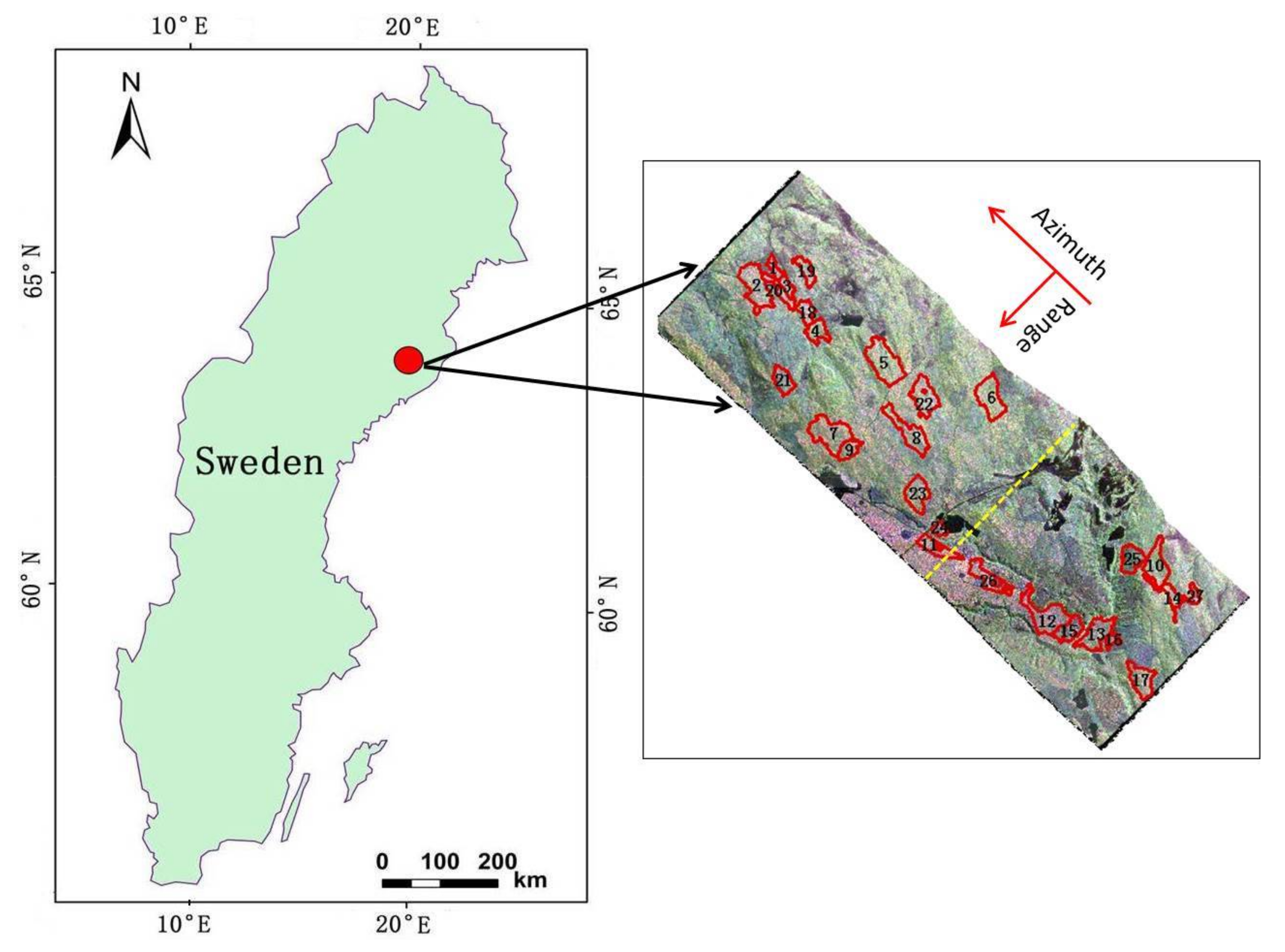
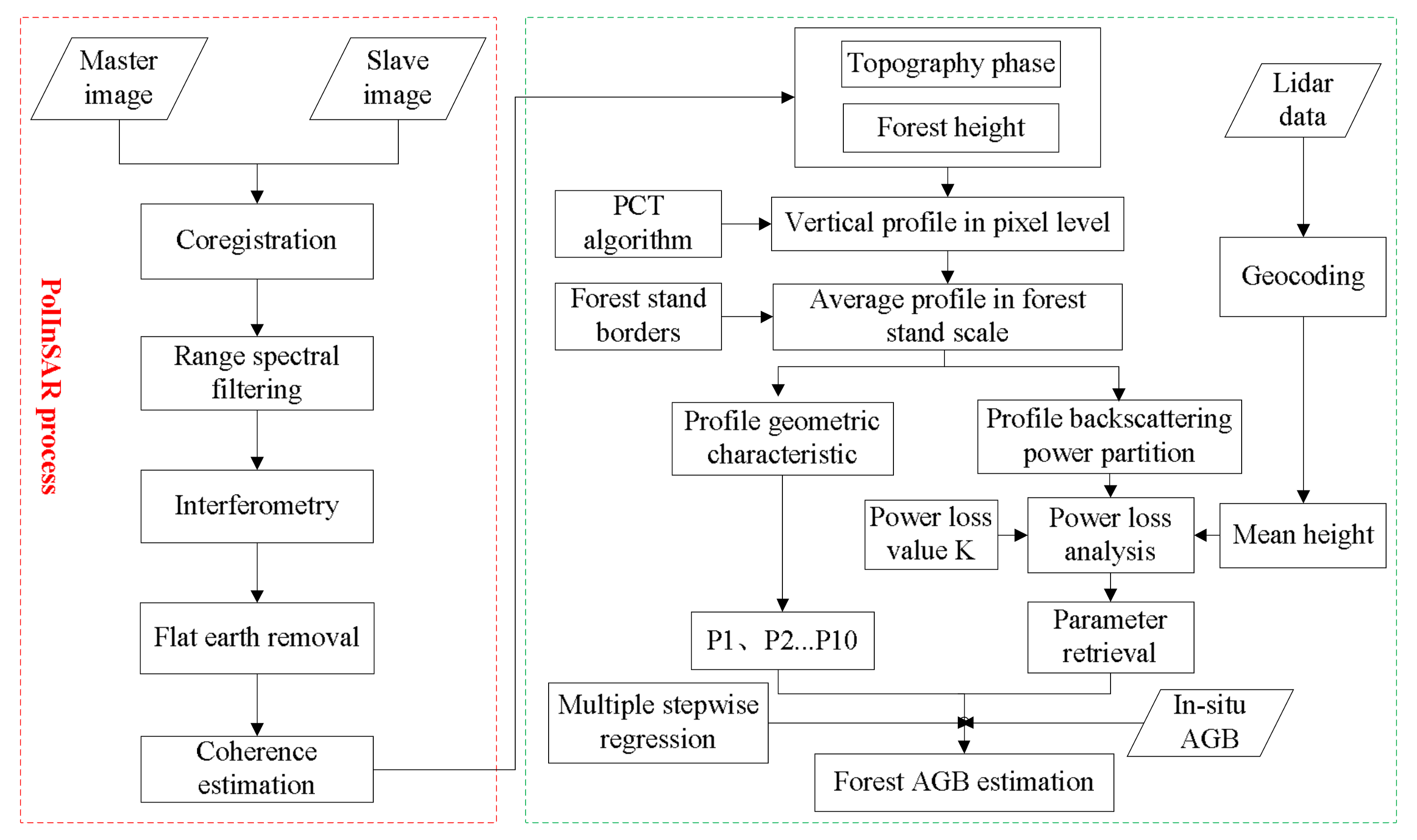

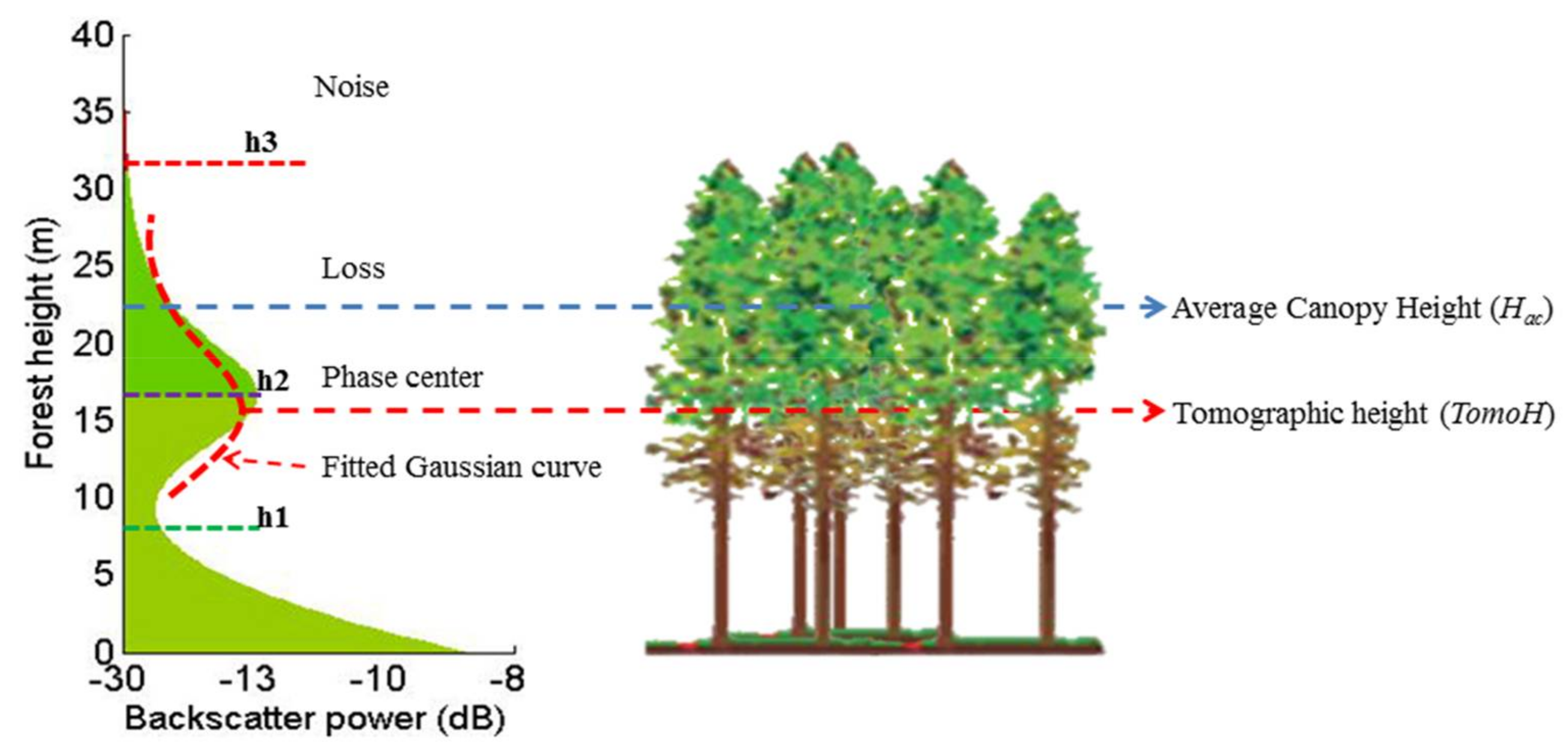
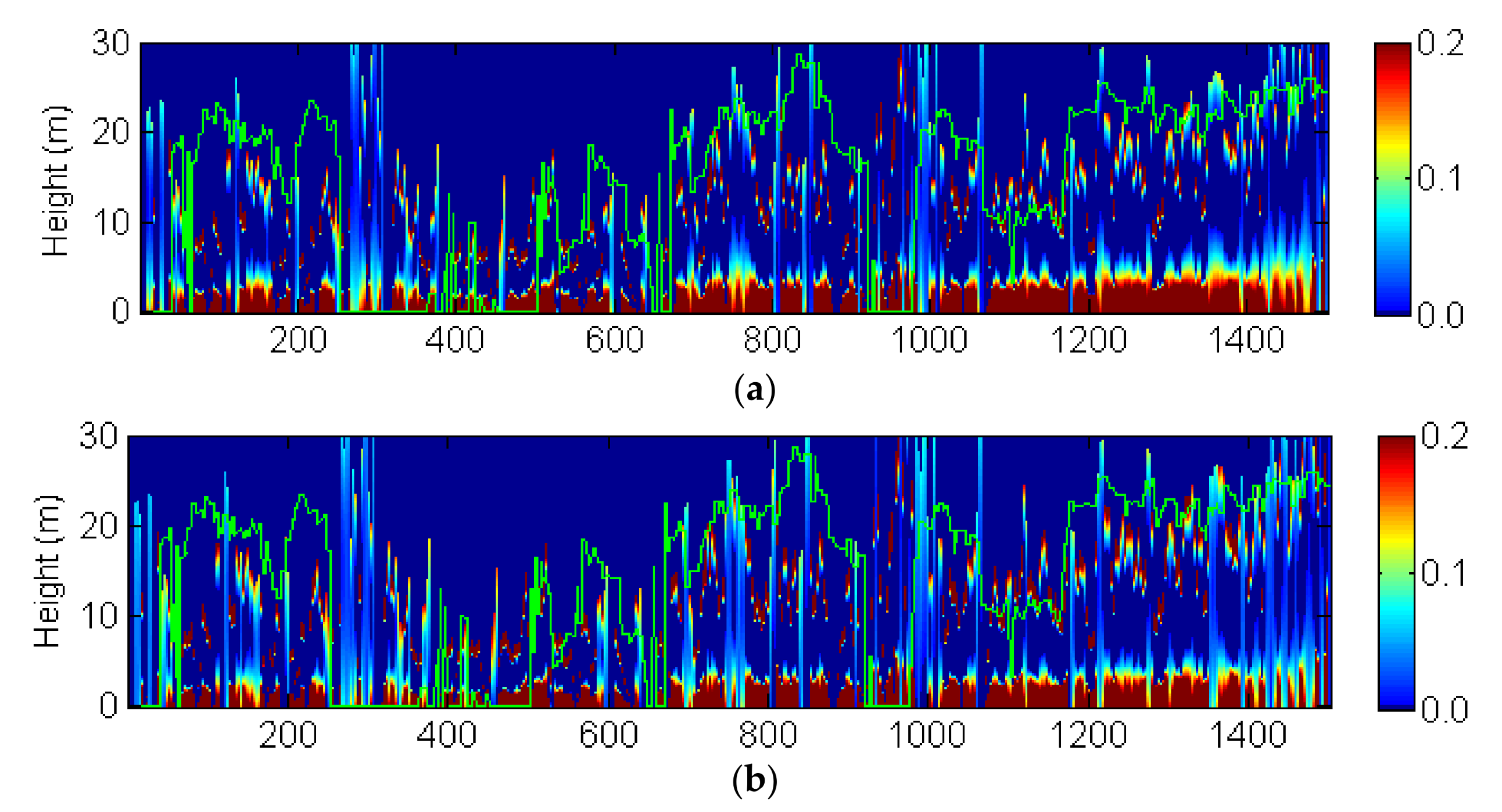
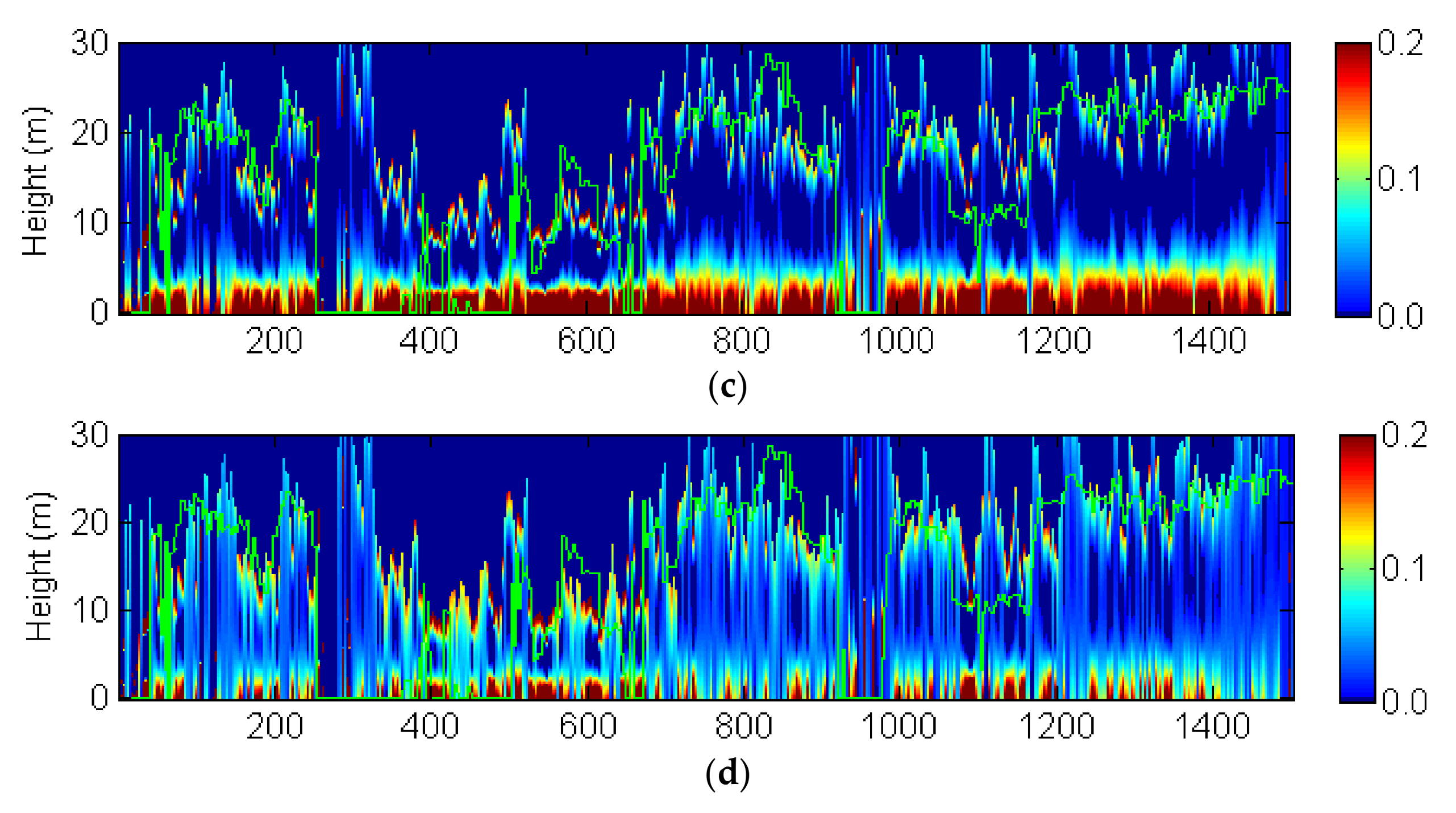
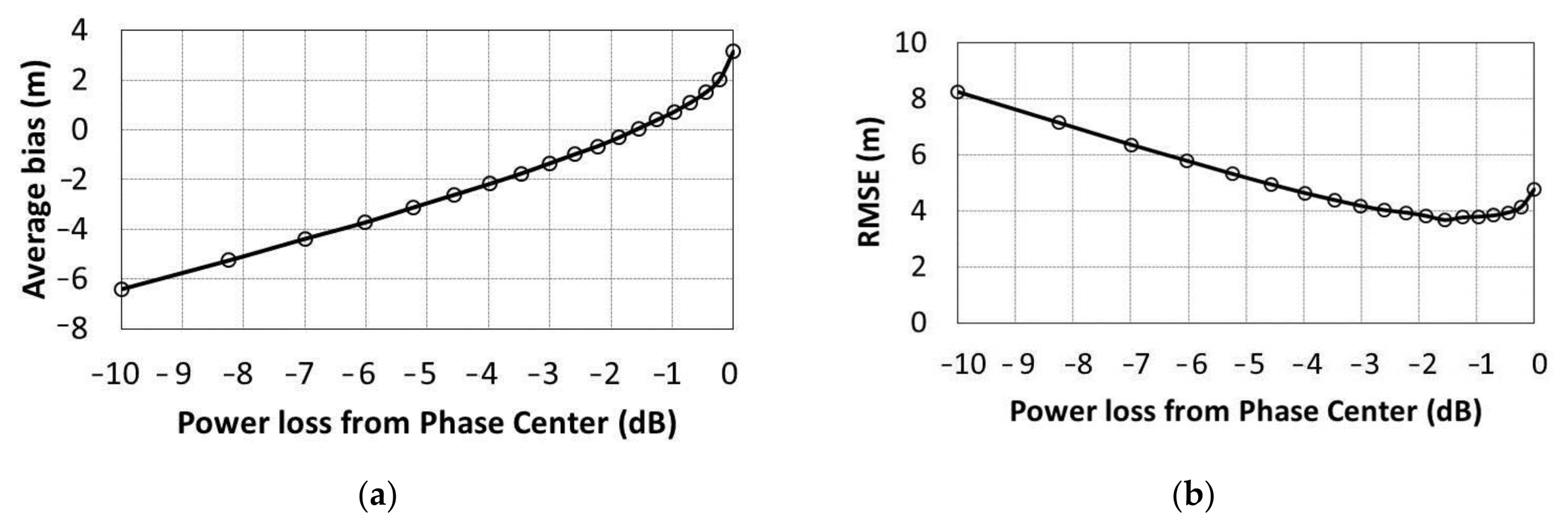
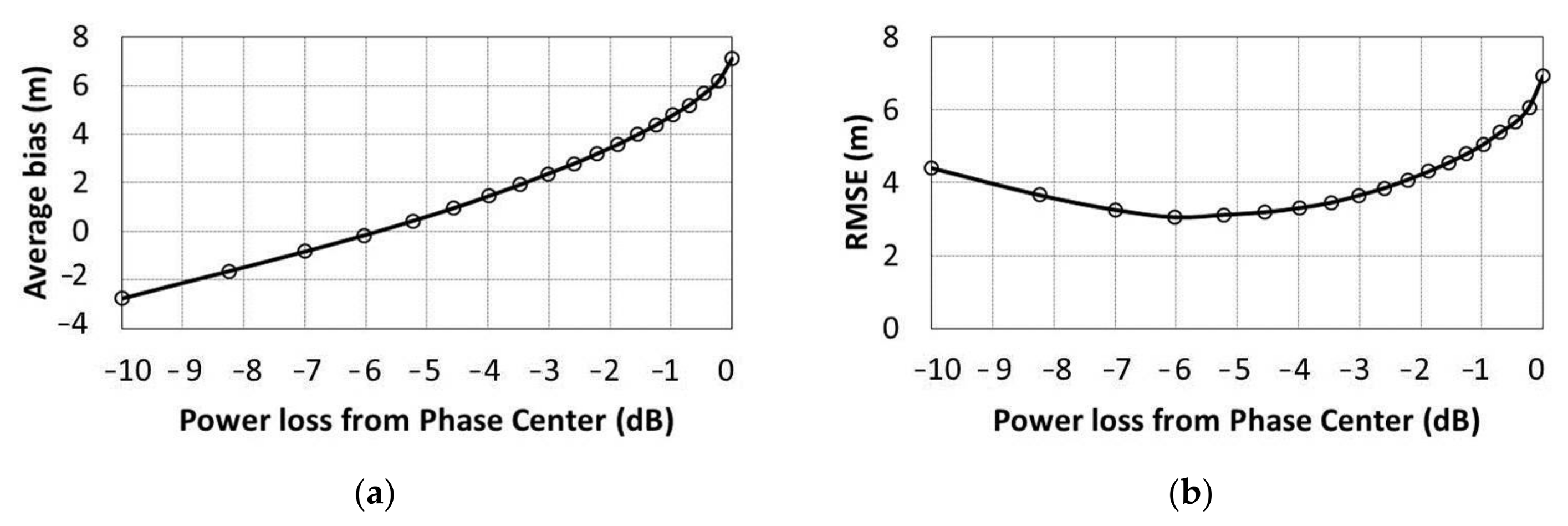





| ID | Mean DBH (cm) | Mean Height (m) | Mean Age (Year) | Biomass (t ha−1) |
|---|---|---|---|---|
| 1 | 17.6 | 13.07 | 77.45 | 72.39 |
| 2 | 20.8 | 14.08 | 61.22 | 69.22 |
| 3 | 17.11 | 13.12 | 57.05 | 58.56 |
| 4 | 23.76 | 16.94 | 107.46 | 103.68 |
| 5 | 23.1 | 17.69 | 11.28 | 134.51 |
| 6 | 28.35 | 21.41 | 12.24 | 182.54 |
| 7 | 26.54 | 18.06 | 131.92 | 119.13 |
| 8 | 16.95 | 15.41 | 57.38 | 106.24 |
| 9 | 28.31 | 19.59 | 143.72 | 139.76 |
| 10 | 28.84 | 20.15 | 140.52 | 167.11 |
| 11 | 26.37 | 17.36 | 157.15 | 116.46 |
| 12 | 21.41 | 15.39 | 63.09 | 74.28 |
| 13 | 22.67 | 17.13 | 127.8 | 86.03 |
| 14 | 25.64 | 18.81 | 114.4 | 158.23 |
| 15 | 17.34 | 12.31 | 52.99 | 35.08 |
| 16 | 18.28 | 13.23 | 83.72 | 85.6 |
| 17 | 21.32 | 15.77 | 124.83 | 89.31 |
| 18 | 21.36 | 15.73 | 124.87 | 108.99 |
| 19 | 18.76 | 14.26 | 90.67 | 119.8 |
| 20 | 19.17 | 13.87 | 86.88 | 84.45 |
| 21 | 12.02 | 9.56 | 34.85 | 42.71 |
| 22 | 21.01 | 16.58 | 76.19 | 95.75 |
| 23 | 27.53 | 17.37 | 144.12 | 111.96 |
| 24 | 20 | 13.93 | 117.7 | 110.78 |
| 25 | 23.6 | 15.99 | 93.27 | 73.8 |
| 26 | 8.65 | 7.51 | 30.62 | 27.46 |
| 27 | 22.01 | 15.77 | 101.06 | 112.82 |
| Sensor | Band | Polarization | Flight Tracks | Purpose | Acquisition Time | Temporal Baseline | Kz |
|---|---|---|---|---|---|---|---|
| E-SAR | P | Full | 314° | Master | 2008-10-14 11:44:14 | 70 min | 0.05–0.24 |
| E-SAR | P | Full | 314° | Slave | 2008-10-14 12:55:21 | ||
| E-SAR | P | Full | 134° | Master | 2008-10-14 11:52:35 | 71 min | 0.02–0.26 |
| E-SAR | P | Full | 134° | Slave | 2008-10-14 13:03:38 |
| Parameter | Description |
|---|---|
| P1 | the ratio of the peak value to the first envelope span |
| P2 | the integral of the relative reflectivity multiplied with the height in the first envelope |
| P3 | the maximum probability of the fitted Gaussian function of the first envelope |
| P4 | the mean of the fitted Gaussian function of the first envelope |
| P5 | the standard deviation of the fitted Gaussian function of the first envelope |
| P6 | the reciprocal of the relative reflectivity summation of the first envelopes |
| P7 | the reciprocal of the relative reflectivity summation of the second envelopes |
| P8 | the ratio of P6 to P7 |
| P9 | the relative reflectivity summation between h1 and h2 multiplied by the relative reflectivity summation between h2 and h3 |
| P10 | the integral of the relative reflectivity multiplied by the corresponding height from 0 to h3 |
| Models | Computing Formula | R2 | Tolerance | VIF | Validated Error |
|---|---|---|---|---|---|
| Hac1 | ln(B) = −3.797 + 1.866ln(Hac) − 2.977ln(P6) | 0.704 | 0.919, 0.919 | 1.088, 1.088 | 0.392, 0.138 |
| Hac2 | ln(B) = −9.363 + 2.414ln(Hac) − 6.276ln(P6) − 1.563ln(P7) | 0.769 | 0.668, 0.341, 0.363 | 1.497, 2.930, 2.757 | 0.397, 0.091 |
| Hac3 | ln(B) = −3.829 + 2.019ln(Hac) − 2.563ln(P6) | 0.734 | 0.904, 0.904 | 1.106, 1.106 | 0.163, 0.276 |
| Hac4 | ln(B) = −10.007 + 2.401ln(Hac) − 6.288ln(P6) − 1.671ln(P7) | 0.791 | 0.655, 0.299, 0.327 | 1.527, 3.342, 3.056 | 0.025, 0.524 |
| Hac5 | ln(B) = −3.899 + 2.034ln(Hac) − 2.586ln(P6) | 0.720 | 0.894, 0.894 | 1.118, 1.118 | 0.167, 0.485 |
| Hac6 | ln(B) = −10.072 + 2.414ln(Hac) − 6.319ln(P6) − 1.667ln(P7) | 0.789 | 0.656, 0.300, 0.333 | 1.526, 3.336, 3.007 | 0.061, 0.529 |
| Hac7 | ln(B) = −4.010 + 2.020ln(Hac) − 2.751ln(P6) | 0.720 | 0.898, 0.898 | 1.113, 1.113 | −1.025, 0.466 |
| Hac8 | ln(B) = −10.334 + 2.421ln(Hac) − 6.508ln(P6) − 1.746ln(P7) | 0.798 | 0.658, 0.311, 0.343 | 1.519, 3.214, 2.918 | 0.043, 0.515 |
| Hac9 | ln(B) = −3.307 + 1.887ln(Hac) − 2.422ln(P6) | 0.704 | 0.907, 0.907 | 1.102, 1.102 | 0.267, 0.257 |
| Hac10 | ln(B) = −8.508 + 2.195ln(Hac) − 5.567ln(P6) − 1.447ln(P7) | 0.756 | 0.667, 0.308, 0.336 | 1.498, 3.246, 2.979 | 0.171, 0.236 |
| Hac11 | ln(B) = −3.784 + 1.883ln(Hac) − 2.918ln(P6) | 0.708 | 0.917, 0.917 | 1.091, 1.091 | 0.055, 0.388 |
| Hac12 | ln(B) = −9.415 + 2.230ln(Hac) − 6.270ln(P6) − 1.580ln(P7) | 0.773 | 0.670, 0.344, 0.367 | 1.492, 2.908, 2.726 | 0.032, 0.395 |
| Hac13 | ln(B) = −4.081 + 2.033ln(Hac) − 2.777ln(P6) | 0.715 | 0.888, 0.888 | 1.127, 1.127 | 0.069, 0.478 |
| Hac14 | ln(B) = −10.166 + 2.418ln(Hac) − 6.387ln(P6) − 1.686ln(P7) | 0.790 | 0.661, 0.316, 0.353 | 1.513, 3.167, 2.831 | 0.061, 0.528 |
| TomoH1 | ln(B) = −3.544 + 1.789ln(TomoH) − 3.277ln(P6) | 0.615 | 0.840, 0.840 | 0.493, 0.233, 0.274 | 0.136, 0.055 |
| TomoH2 | ln(B) = −13.199 + 2.437ln(TomoH) − 9.115ln(P6) − 2.539ln(P7) | 0.723 | 0.502, 0.230, 0.266 | 1.992, 4.352, 3.758 | −0.087, 0.042 |
| Hac15 | ln(B) = 2.172 + 1.588ln(Hac) + 2.419ln(P6) | 0.744 | 0.954, 0.954 | 1.049, 1.049 | 0.165, 0.132 |
| Hac16 | ln(B) = 3.876 + 1.468ln(Hac) + 3.505ln(P6) + 0.417ln(P7) | 0.785 | 0.868, 0.592, 0.539 | 1.152, 1.689, 1.854 | 0.201, 0.023 |
| TomoH3 | ln(B) = 3.333 + 0.691ln(TomoH) + 2.951ln(P6) | 0.706 | 0.905, 0.905 | 1.105, 1.105 | −0.307, 0.216 |
| TomoH4 | ln(B) = 5.189 + 0.646ln(TomoH) + 4.736ln(P6) − 0.514ln(P7) | 0.730 | 0.880, 0.456, 0.426 | 1.136, 2.191, 2.347 | −0.353, 0.069 |
© 2018 by the authors. Licensee MDPI, Basel, Switzerland. This article is an open access article distributed under the terms and conditions of the Creative Commons Attribution (CC BY) license (http://creativecommons.org/licenses/by/4.0/).
Share and Cite
Zhang, H.; Wang, C.; Zhu, J.; Fu, H.; Xie, Q.; Shen, P. Forest Above-Ground Biomass Estimation Using Single-Baseline Polarization Coherence Tomography with P-Band PolInSAR Data. Forests 2018, 9, 163. https://doi.org/10.3390/f9040163
Zhang H, Wang C, Zhu J, Fu H, Xie Q, Shen P. Forest Above-Ground Biomass Estimation Using Single-Baseline Polarization Coherence Tomography with P-Band PolInSAR Data. Forests. 2018; 9(4):163. https://doi.org/10.3390/f9040163
Chicago/Turabian StyleZhang, Haibo, Changcheng Wang, Jianjun Zhu, Haiqiang Fu, Qinghua Xie, and Peng Shen. 2018. "Forest Above-Ground Biomass Estimation Using Single-Baseline Polarization Coherence Tomography with P-Band PolInSAR Data" Forests 9, no. 4: 163. https://doi.org/10.3390/f9040163





